January 15, 2009
community, General, gnome, guadec, maemo
4 Comments
I just bought a round trip for the Gran Canaria Desktop Summit, flying out on July 3rd and returning on July 11th, with Europa Air, from Lyon to Las Palmas via Madrid, for €254 including taxes. I found the ticket on Expedia.
This is, quite frankly, very cheap – and I expect that ticket prices will only start going up from here on in.
To all those planning on attending: please buy your tickets now.
If you need some travel assistance, buy the tickets now, and keep a receipt, and ask for assistance afterwards. The longer you wait, the more expensive your ticket will cost, and the less likely it will be that we will be able to partially or fully reimburse you.
It might be worth your while checking ticket prices via a travel agency – since this is a holiday destination, the travel agency may have access to charter flights which aren’t listed on sites like lastminute or expedia. Also, have a look at Easyjet, a budget airline that can give you really cheap flights and isn’t listed in the online reservation sites.
December 26, 2008
community, gnome, guadec, maemo
2 Comments
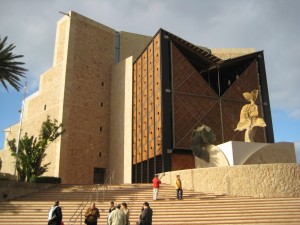
The Auditorium building
Last week, I travelled with vuntz to Gran Canaria, where we met up with Alberto Ruiz, Sebastian Kügler, Will Stephenson and Claudia Rauch, along with the local organising team Augustín, Miki, Kuka and others to have a series of meetings about the upcoming Gran Canaria Desktop Summit (July 3rd to July 11th 2009).
We had a series of press conferences and interviews interspersed with meetings with the local organising team, among ourselves, with the Cabildo (the local government), and the management of the conference center on a very wide range of topics (and I plan on writing a post or two on some of the interesting issues we’re facing another time).
The conference will be held in the Auditorium, a “palacio de congresos” near the beack in Las Palmas:
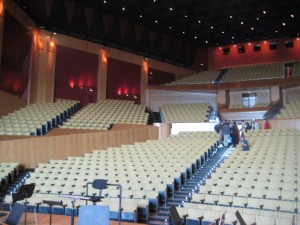
View from the stage of the symphony hall
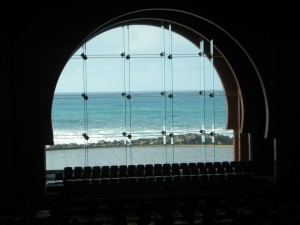
View from the peanut gallery
This is an amazing theater, and well fit for a symphony orchestra, and on the first day of the conference, the 4th of July, we plan to fill over 1000 seats.
Some of the goals of the conference this year, from the point of view of the Cabildo who are supporting us, are to increase local awareness of free software as a credible alternative, and to grow the local free software industry. As part opf these, we will be working to run some Spanish language tutorials and presentations, and the Cabildo’s press office will be working hard to ensure that the conference opening will get some great media coverage.
With that said, it was reassuring to heard Dr. Roberto Moreno of the Cabildo reinforce his committment to have a conference for the communities, and not let politics and media get in the way of getting together and working. I am hopeful that we can reconcile both, and have some nice local and international coverage of cool stuff coming out of the communities who will be attending.
The conference center is much larger than the symphony hall, and there are some beautiful conference facilities available to us. Space is money, however, so to get the most out of the generous Cabildo support, and to get the most out of the conference, we should limit the space we request (again, no-one wants to see half-empty theaters). We will likely be using the two San Borondón halls plus the Alegranza hall for the major parts of the conference, with a couple of other halls for smaller presentations.
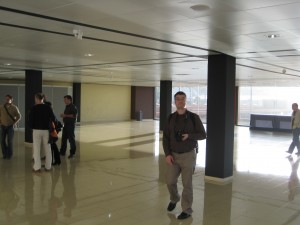
Sebas from KDE in the Alegranza Hall
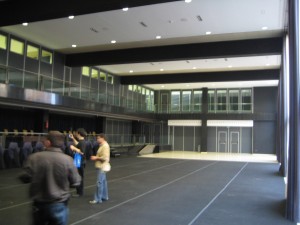
San Borondón A
What you don’t see in the pictures is the magnificent panoramic view of the sea which you have in the Alegranza Hall (where we’re thinking of putting sponsors stands and hang-out space) or the similarly-sized but lower-ceilinged room (San Borondón B) to the left of San Borondón A, which can be split into 5 classroom-sized halls for small presentations or BOFs.
The visit went great, and reassured me that everyone is more or less on the same wavelength. We’re a little behind on a couple of things, but nothing we can’t catch up with quickly, I hope. The local team are great, and I expect the conference to become *the* place to go for free desktop developers all through the stack (from FreeDesktop.org to application developers) this July.
December 2, 2008
community, maemo
3 Comments
Reggie Supildo announced today something that we’ve been talking about for a while now – ITt will be coming under the maemo.org umbrella. Internet Tablet Talk, for those who don’t know, is a community-run forum where members have always been unfettered in their praise and criticism of Maemo, and of Nokia’s running of the project. And they will continue to be unfettered – as part of maemo.org.
This is very exciting – the ITt forums have always been a kind of world apart, and to be honest it’s been hard to follow what’s been going on there. There are hundreds of contributors, and dozens of new posts every day, on all matters related to Maemo and Nokia’s internet tablets.
We’ve been getting progressively closer for the past few months – ITt news items are syndicated in the Maemo news feed, and we have a recently added Karma plug-in for ITt posts. This is a logical next step. Of course, ITt will continue to be run by Reggie and Roger, and aside from retheming the site to match maemo.org, users will hopefully notice little in the operation of the site. But my hope is that ITt users will feel a little more like part of the Maemo community, once the forum is on maemo.org. This is one more piece in Maemo’s journey from a Nokia-run project to a Nokia-sponsored, community-run project.
October 17, 2008
gnome, maemo, marketing
No Comments
It’s been a quiet day in GNOMEland here in Lyon. Not too many people around the JDLLs this year – hopefully things will be more lively tomorrow, and some lessons will be learned for the organisation for next year.
I finally got some A1 & A2 posters printed up that look very nice, if I may say so myself – special credit to artists & contributors andreasn, mizmo & zagorskid for the material.
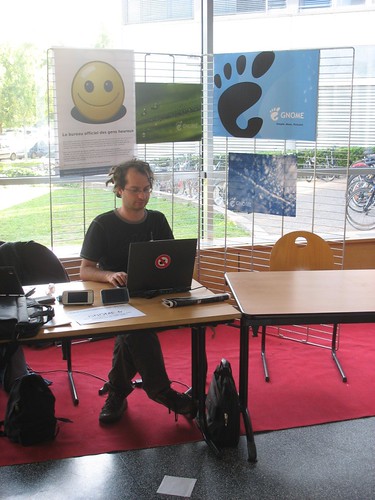
Fredp, looking zen, at JDLL 08 in Lyon
Along with some “Why choose GNOME?” hand-outs, a Nokia N810, Nokia N800, a couple of laptops, and fredix, Dodji fredp and myself, the stand is looking not too shabby – could be better, could be worse. Tomorrow Dodji will be gone, but vuntz will be here.
September 25, 2008
community, maemo
2 Comments
To follow on from various discussions and the unfortunately short BOF we had on this subject in Berlin, Ryan Abel (who couldn’t make it to the summit) suggested holding an informal IRC meeting to talk about the next steps in the maemo.org revamp.
The IRC meeting will be at 19:00 UTC on Saturday the 27th of September, on the #maemo-meeting channel on irc.freenode.net.
After the Summit, I believe that the basic elements of the changes we want to make are now well understood. Our dual goal is to reorganise existing information to provide the most relevant information to people who are coming to the site from outside the community, while catering to the different needs of people who are long-time members of the community. We’re going to do this by reorganising existing content where possible, rather than attempt to completely redesign the site.
September 19, 2008
community, freesoftware, maemo, work
4 Comments
Coming to the end of the first day of the Maemo Summit in C-Base in Berlin. From just outside, you have a view of the antenna of the space station that the C-Base group have been mapping out for the past few years. For those who don’t know, this is the terraforming space station which brought life to earth, and which crashed in what is now Berlin 4.5 billion years ago. Only the central tower, now in use as a television tower, is visible above ground.
The two days in OSiM World were useful and educational. I got to meet people from companies trying to learn how to work well with Free Software, which gave a great opportunity to affect real change by talking to the decision makers in those companies. I also got to meet some Maemo people who came to OSiM to meet up and hang out at the Maemo/Nokia stand (by far the most active stand in the conference, by the way).
But the Maemo Summit is a refreshing counter-weight to that – some of the observations that people made this morning were:
- We got better wireless and power for free than at the high-powered conference people paid thousands of euros to attend (given that the CCC is involved in C-Base, that was not surprising to me)
- The vocabulary has totally shifted. We’ve moved from value propositions, cost-benefit analysis, return on investment and fragmentation to people getting excited about tracemonkey, PowerVR, OMAP3, Clutter, hacks, crashes and bugs… the people who are down in the trenches and know what free software is are here.
- Less suits, more t-shirts
It has been an amazing day so far – some big news from Peter Schneider this morning that the interface for the Fremantle will be Clutter based – Rodrigo Novo went into more details: Nokia are funding new tablet-oriented widgets and off-screen support for GTK+, the integration of Clutter, and more.The lightning talks were fascinating for the breadth and depth of things which people are doing with Maemo – everything from using them in police cars to porting PyPy through running Debian in a chrooted environment as a Maemo application (presentation given in OO.o running in said Debian on an N810!!!).
As usual, what’s most impressive at these things is meeting old friends and making new ones. I’ve got to spend lots of time with Stormy, Paul Cooper, Jim Zemlin, Lefty, Bdale and others, and today I had a chance to have a good chat with Rob Taylor, Philippe Kalaf, Murray Cumming, Simon Budig and more. I was very happy to put a face to Tero Cujo’s name, the latest addition to Nokia’s maemo.org team. I’m a little disappointed not to have met anyone from Nemein here yet after working with them for so long – but Henri is in Korea for an international Haedong Kumdo competition, and getting his 23rd Dan (or something like that) confirmed by a master while there.
In addition to the summit, there is also a desktop search hackfest happening over the next two days, with people involved in Tracker, Beagle and Xesam getting together to agree on interfaces and work on implementation, to bring rocking search to desktops and tablets of the future.
There’s a heavy GNOME influence at the conference, which makes the various noises I hear about Nokia backing away from GNOME seem exceedingly over-stated. It looks to me like Nokia are using more and more of the GNOME and freedesktop.org stack, and are more than any other company right now setting a direction for GNOME in the future with investments in technologies like Clutter.
So far, great stuff! Looking forward to the party tonight, and day 2 tomorrow.
September 18, 2008
community, maemo
2 Comments
Last night, “the Roaming Gnomes”, a team I put together, participated in the ACCESS pub quiz at OSiM World, organised by Lefty Schlesinger.
Lefty ran a Jeopardy-type quiz which was raucous, fun, energetic, competitive, and replete with a Windows Vista crash and a Flock bug. A bunch of teams had a go at questions in categories that included “Open source personalities”, “Comics and Movies”, “Mobile industry history”, “History of computing” and some general knowledge categories. And in the end, the best team won.Us! (Update: Now includes a photo of the winning team – Bdale and Jim got shy, and Niels had to leave early, and I think it’s Heikki who also missed the photo).
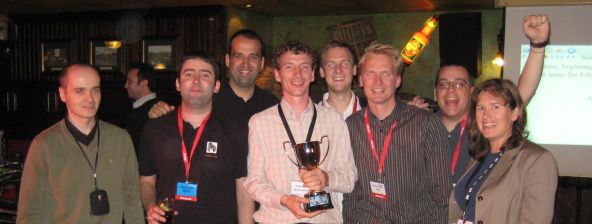
The Roaming GNOMEs
So here’s the role call of the Roaming Gnomes heros who helped bring the huge trophy to GNOME.
- Dave Neary
- Stormy Peters
- Paul Cooper (a two-time winner!)
- Alejandro, Alberto and Juanjo of Igalia
- Thomas Jansson
- Richard Rojfors
- Heikki Paajaken
- Bdale Garbee (our resident computing historian)
- Jim Zemlin
- Niels Breet (special mention for knowing the answer to which country has a wife-carrying race)
Congratulations to Lefty on running a very successful quiz – it was a good range of questions, and the rules change mid-game definitely contributed to the animation of the competition. And thanks once more to all the members of the team.
September 15, 2008
community, freesoftware, maemo, work
2 Comments
On Thursday I’ll be participating in a panel at OSIM World – “Effectively Building and Maintaining an Open Source Community”. It was a happy coincidence when I saw Matt Asay writing about the issue on Friday, and again today – it gives me a chance to think a bit more about the issues involved, and provides a data point which is very close to the experience that I have repeatedly seen when companies decide to use free software, be it peripherally or strategically.
On several occasions I have seen a lone developer decide to use a free software library to do some job for him. It doesn’t quite fit his needs, but he hacks up the extra feature or two in a couple of days, finds a few bugs that he fixes along the way to make things work as he needs them to, and ships it to a client as part of a larger solution.
At this point, one of two things will happen. The external project either stays as-is in the SCM of the company, awaiting a future upgrade request from the client, or the developer (usually because he is “the Linux guy” in the company and knows about these things) bundles up a couple of patches, heads along to the bug database for the project, signs up for Yet Another Bugzilla Account, and creates three or four bug entries with bug fixes attached, and another one for the new feature he hacked up. All told, he spends maybe half a day cooking up patches, navigating account creation, and submitting his work.
Usually, the patches will sit there for weeks or months before being reviewed. In most projects, if you don’t go onto a mailing list or IRC channel and ask the right guy to take the time to look at them, you can expect to wait. He has a backlog, gets lots of bugzilla nag mail already, and anyway, he’s working on a new feature he wants to get done this weekend between playing with the kids and doing the grocery shopping.
When they do get reviewed, the code base is likely to have shifted, so the patches don’t apply cleanly. Perhaps they don’t conform accurately to the coding conventions of the project. The feature, while useful, was done quickly (since it was only a minor part of a larger project), wasn’t accompanied by unit tests, and has a couple of issues that need resolving.
Of the four or five bug reports that our hacker created, one gets marked INVALID, another one is a DUPLICATE, and one patch gets applied and the bug fixed. The feature request status gets set to NEEDINFO, since there are some open issues to be addressed, but our hacker is now 6 months away from the code, 3 projects down the line, and has less time to write unit tests, review and resubmit the code.
Maybe he’ll do it anyway – and maybe he won’t.
In fact, I would say that the vast majority of the features people code up for free software projects never make it into an upstream bugzilla – developers are perfectly happy shipping a 10 year old version of GNU Kermit with hairy patches sticking out all over the place. And of those patches that do make it into an email or bugzilla, a small percentage ever make it into the upstream code base.
I would argue that when a project is strategic to a company product (as Lucene is to Alfresco), then the company has every interest in having someone who is regularly contributing to the project, who knows the key people in the community, and who is a trusted member of the community themselves. This ensures that your code is getting the care and attention it deserves when submitted upstream, and helps contribute to reducing your maintenance cost long run (as well as giving you influence over a project you depend on).
All this is to say that reducing the argument to “throw code over wall bad, participate good” is slightly over-simplifying – in the case where the project is a core part of your business, I agree wholeheartedly. If you’re using free software libraries as product, and merely tweaking to your needs, then the cost of participating outweighs the benefits in most cases. Reducing that cost by lowering the barrier of entry to participating is key to developing a vibrant community. But increased availability and a very low barrier to entry also incurs a cost on the community. Like most community-related issues, the balancing act is not an easy one to get right.
September 11, 2008
maemo
4 Comments
With the Maemo community council elections over, I’d like to congratulate the newly elected council. Good luck to Eduardo Lima, Andrew Flegg, Ryan Abel, Simon Pickering and Tim Samoff, who will make up the inaugural community council.
The council serves for a six month term, so they have a big job in front of them to define its role, and ensure it’s relevant to the Maemo community for years to come.
September 8, 2008
gnome, maemo
No Comments
The Maemo community council election has been running for 5 days now, and voting closes at midnight Wednesday – I’ll be announcing the new council (subject to any contestations, protests, etc) on Thursday the 11th, one week before the Maemo community gets to meet in person in Berlin for the Maemo Summit.
If you think you should have a ballot, and you haven’t received one last Wednesday, please drop me a line.
If you have received a ballot and haven’t voted yet, please do so – there is only a little more than 2 days left to the election closing.
While I’m talking about the election, I’d like to thank GNOME for the election software we stole^Wborrowed and got working^W^Ware using for the election. I hope that the instructions which I wrote for the module are useful, and end up getting included in the foundation-web module.
Thanks also to Henri Bergius from Nemein, who got the software installed and has been my hands and eyes for the past few days on a server to which I don’t have access.
« Previous Entries Next Entries »






